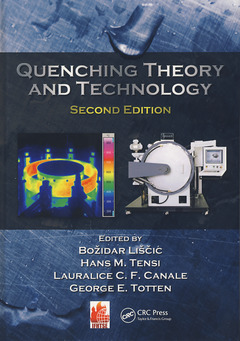Quenching Theory and Technology (2nd Ed.)
Coordonnateurs : Liscic Bozidar, Tensi Hans M., Canale Lauralice C.F., Totten George E.

Quenching is one of the most fundamentally complex processes in the heat treatment of metals, and it is something on which mechanical properties and distortion of engineering components depend. With chapters written by the most respected international experts in the field, Quenching Theory and Technology, Second Edition presents the most authoritative, exhaustive, and recent findings in this vital area. Understanding and control of quenching and quenchants is a critical constant in all well established and emerging heat treatment process technology. The collection of up-to-date knowledge in this book is the latest outcome from continuing formal and informal discussions by experts within the framework of the International Federation for Heat Treatment and Surface Engineering (IFHTSE).
It covers topics including:
- Thermo-and fluid dynamic principles of heat transfer during cooling
- Wetting kinematics
- Residual stresses after cooling
- Computer modeling and prediction of microstructure transformation
- Hardness distribution
- Stress-strain and distortion
With revised and updated content from the first edition, this book adds coverage of important technological developments. Although the primary focus continues to be on the quenching of steel, it also details quenching of aluminum and titanium alloys, quench severity of selected vegetable oils, gas quenching, intensive quenching, and simulation of quenching. Presenting the most recent findings in this area, this essential piece of literature is a substantial contribution to the general field of the thermal processing of metals. It is useful not only for specialists in heat treatment practice, but also those in higher education or numerous specialized courses and seminars worldwide.
Hardening of Steels. Quenching of Aluminum Alloys. Quenching of Titanium Alloys. Mechanical Properties of Ferrous and Nonferrous Alloys after Quenching. Thermo- and Fluid-Dynamic Principles of Heat Transfer during Cooling. Heat Transfer during Cooling of Heated Metals with Vaporizable Liquids. Wetting Kinematics. Wetting Kinetics and Quench Severity of Selected Vegetable Oils for Heat Treatment. Residual Stresses after Quenching. Effect of Workpiece Surface Properties on Cooling Behavior. Determination of Quenching Power of Various Fluids. Types of Cooling Media and Their Properties. Gas Quenching. Techniques of Quenching. Intensive Steel Quenching Methods. Prediction of Hardness Profi le in Workpiece Based on Characteristic Cooling Parameters and Material Behavior during Cooling. Simulation of Quenching. Appendices. Index.
Božidar Liščić received his BS in Mech. Engineering (1954) from the University of Zagreb (Croatia), and his Ph.D.in Material Science (1975) from the same university. He is a full professor (retired) of the Faculty for Mechanical Engineering and Naval Architecture the University of Zagreb. From 1971-1990 he served as UNDP Expert for Heat Treatment in: Israel, India, Egypt, Turkey, Bangladesh and Pakistan. Prof. Liščić is past-president of the International Federation for Heat Treatment and Surface Engineering (IFHTSE), and a Fellow of ASM International. From 2003 to 2008 he was member of the Standing Committee for Physical and Engineering Sciences of the European Science Foundation (ESF). He is a Founding member of the ASM-Heat Treating Society, and a Full member of the Croatian Academy of Sciences and Arts. Prof. Liščić is author or coauthor of over 100 publications, and contributed to the following books: Technologie der Wärmebehandlung von Stahl, Theory and Technology of Quenching (editor), Steel Heat Treatment Handbook, and Steel Heat Treatment Handbook-Second Edition- Metallurgy and Technologies.
George E. Totten, Ph.D. is President of G.E. Totten & Associates, LLC in Seattle, Washington and a visiting professor of Mechanical and Materials Engineering at Portland State University, Portland, OR, USA. Dr. Totten is co-editor of a number of books including Steel Heat Treatment Handbook, Handbook of Aluminum, Handbook of Hydraulic Fluid Technology, Mechanical Tribology, and Surface Modification and Mechanisms (all titles of CRC Press), as well as the author or coauthor of over 500 technical papers, patents and books on lubrication, hydraulics and thermal processing. Dr. Totten is a Fellow of ASM International, SAE International, the International Federation for Heat Treatment and Surface Engineering (IFHTSE) and the American Society for
Date de parution : 07-2010
Ouvrage de 616 p.
17.8x25.4 cm
Thèmes de Quenching Theory and Technology :
Mots-clés :
Heat Transfer Coef Cient; Nucleate Boiling; Hardening of Steels; Lm Boiling; Heat Transfer during Cooling of Heated Metals with Vaporizable Liquids; Vapor Blanket; Wetting Kinematics; Cooling Rate; Types of Cooling Media and Their Properties; Heat Ux Densities; Simulation of Quenching; Leidenfrost Temperature; Heat Ux; Cooling Curves; Martensitic Transformation; Residual Stresses; Convection Heat Transfer Coef Cient; Oil Quenchants; Cooling Curve Analysis; Quenching Medium; Polymer Quenchant; TTT Diagram; Quenched End; Gas Quenching; Vacuum Furnaces; Vapor Lm; Martensite Start Temperature; Critical Heat Flux; Wetting Front; Immersion Quenching
